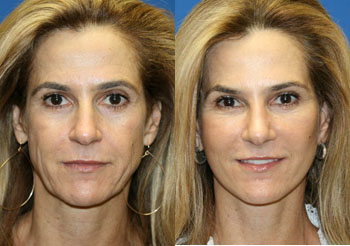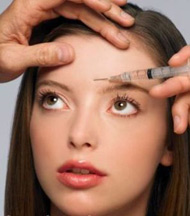| |
|
|
 |
What is facelift surgery?
If you are bothered by signs of aging in your face, facelift surgery may be right for you. Technically known as rhytidectomy, a facelift is a surgical procedure to improve visible signs of aging in the face and neck, such as:

- Sagging in the midface
- Deep creases below the lower eyelids
- Deep creases along the nose extending to the corner of the mouth
- Fat that has fallen or is displaced
- Loss of muscle tone in the lower face may create jowls
- Loose skin and excess fatty deposits under the chin and jaw can make even a person of normal weight appear to have a double chin
Rejuvenation procedures typically performed in conjunction with a facelift are brow lift, to correct a sagging or deeply furrowed brow, and eyelid surgery to rejuvenate aging eyes.

What facelifts won't do:
As a restorative surgery, a facelift does not change your fundamental appearance and cannot stop the aging process.
Is it right for me?
A facelift can only be performed surgically; non-surgical rejuvenation treatments cannot achieve the same results, but may help delay the time at which a facelift becomes appropriate and complement the results of surgery. Facelift surgery is a highly individualized procedure and you should do it for yourself, not to fulfill someone else’s desires to to try to fit any sort of ideal image.
Facelift surgery is a good option for you if:
- You are physically healthy
- You do not smoke
- You have a positive outlook and specific, but realistic goals in mind for the improvement of your appearance
A forehead lift is often performed to treat conditions associated with aging. It may be done in conjunction with other cosmetic procedures to achieve a more harmonious facial appearance. A forehead lift is also appropriate for treatment of certain inherited traits. Younger adults who have a low brow or who already have deep frown lines due to stress or over activity of muscles may benefit from the Forehead Lift procedure.
Am I a good candidate for forehead lift surgery?
Any one or combination of the following conditions may indicate that you are a good candidate for a Forehead Lift:
- sagging or low position of the eyebrows, creating a tired or sad appearance
- deep horizontal creases across the forehead
- frown lines, or furrows, between the eyebrows and sometimes across the top of the nose
The face usually portrays the first visible signs of aging. Gravity and changes in eyebrow shape and position results in the brow area looking aged. Most patients requesting evaluation for a Forehead Lift or Facelift feel that their facial features do not reflect their youthful spirit and energy level. They are looking for ways to refresh and rejuvenate their appearance. There are many different variations of the Forehead Lift procedure that improve the position and shape of the eyebrow and forehead areas. Ultimately, the Brow Lift will allow you to turn back the hands of time to better reflect your youthful spirit.
How will my plastic surgeon evaluate me for a forehead lift?
During the pre-operative consultation, your surgeon will perform a history and physical examination. During your physical examination, your facial bone structure, underlying skin structure, brow position, eyelid and eye aesthetics, skin thickness, texture, and elasticity will be assessed. This information will be used to formulate a surgical plan and the goals of the procedure will be discussed. Generally, a Forehead Lift procedure is a very versatile procedure, and your surgeon will explain the technique that he or she feels most comfortable with and that offers the lowest risk. Your plastic surgeon will select the surgical technique that he or she feels will obtain the best outcome for you based on your discussions regarding the outcome you wish to achieve.
How is a forehead lift performed?
The Forehead Lift procedure continues to evolve. Over the years, the procedure has changed from open techniques to more complex short incision and endoscopic techniques. The Forehead Lift procedure usually involves incisions in the hair-bearing scalp. Occasionally, incisions may be performed in the forehead, and/ or the upper eyelids. Once the incisions are made, various degrees of undermining of the skin are performed, and the deeper layers of the forehead are ‘lifted’. Muscles that depress the eyebrows may be disrupted. The skin and deeper layers are often then ‘fixed’ or attached to the bone. The results are a reversal of the effects of gravity and tightening of soft tissues of the forehead to restore a more youthful contour to the upper face.
 How is my plastic surgeon able to improve my frown lines and the position of my eyebrows?
How is my plastic surgeon able to improve my frown lines and the position of my eyebrows?
In many instances, an incision is made across the top of the scalp, beginning above the ears and hidden within the hair. Sometimes, the incision may be placed at the front of the hairline or, in some cases, toward the middle of the scalp. The incision is designed to be inconspicuous when healed. Through the Forehead Lift incision, your plastic surgeon can modify or remove parts of the muscles that cause wrinkling and frown lines, remove excess skin, and lift your eyebrows to a more pleasing level.
Sometimes, if your main concern is frown lines between your eyebrows or across the top of your nose, a limited endoscopic procedure to correct these problems can be done.
Understanding Risks of Forehead Lift Surgery
Fortunately, significant complications from Forehead Lifts are infrequent. Every year, thousands of people undergo successful Brow Lift surgery and are pleased with the results. However, anyone considering surgery should be aware of both the benefits and risks. These are best discussed on a personal basis with your surgeon or one of their qualified staff members.
Some of the potential complications that may occur include hematoma (an accumulation of blood under the skin), infection, and reactions to anesthesia. While plastic surgeons are trained in techniques for safely manipulating facial skin and tissues, injury to underlying structures is possible, though usually temporary. Forehead Lift incisions are usually quite inconspicuous; however, this is not entirely predictable due to individual variations in healing. You can help minimize certain risks by following the advice and instructions given to you by your plastic surgeon both before and after surgery.
Your Forehead Lift Surgical Experience
The goal of your plastic surgery team is to make your surgical experience as easy and as comfortable as possible.
Pre-Operative
If you are a smoker, it is highly recommended to stop smoking well in advance of the surgery. Certain medications that increase the risk of bleeding such as Aspirin, non-steroidal anti-inflammatory medications, and some vitamins/homeopathic regimens should be discontinued prior to surgery. If your hair is short, you may want it to grow out enough to cover your incisions while they heal. Any chemical processing of your hair should be performed prior to surgery since you cannot have any of these procedures for a month of more after surgery. If your Forehead Lift will be performed on an outpatient basis, be sure to arrange for someone to drive you home and stay with you for at least the first night of following surgery.
Day of Surgery
Your Forehead Lift may be performed in a hospital, free-standing ambulatory facility, or office-based surgical suite.
Medications are administered for your comfort during the procedure. You and your plastic surgeon will have decided in advance what type of anesthesia is to be used – either intravenous sedation (twilight) or general anesthesia. For your safety during and after the operation, various monitors are used to check your heart, blood pressure, pulse and the amount of oxygen circulating in your blood.
When surgery is completed, you will be taken into a recovery area. A bandage may be wrapped around your forehead or face. Sometimes small tubes will be inserted beneath the skin to drain away fluid that might otherwise accumulate. There is surprisingly very little discomfort experienced after Forehead Lift surgery. However, any discomfort you may experience will be controlled with pain medication as needed.
You may be permitted to go home after a few hours, although some patients may stay overnight in a hospital or surgical facility.
Recovery
 It is important to realize that the amount of time it takes varies greatly between individuals. Elevation of the head is extremely helpful in reducing the initial post-operative swelling. Your surgeon may also advise you to use ice packs intermittently.
You should avoid Aspirin and non-steroidal anti-inflammatory medications for the first few days after your surgery. Smoking and exposure to second-hand smoke should be avoided to prevent delays in the healing process.
It is important to realize that the amount of time it takes varies greatly between individuals. Elevation of the head is extremely helpful in reducing the initial post-operative swelling. Your surgeon may also advise you to use ice packs intermittently.
You should avoid Aspirin and non-steroidal anti-inflammatory medications for the first few days after your surgery. Smoking and exposure to second-hand smoke should be avoided to prevent delays in the healing process.
How will I look and feel initially?
Once the dressings and drains are removed, puffiness and discoloration may be more pronounced in some portions of the face than others. Do not be alarmed by any unevenness or temporary asymmetry – this is normal. Most swelling is usually noted in the first 24 to 48 hours, and most bruising resolves within 2 weeks. Concealing makeup is usually permitted after the first week. You may experience numbness to the forehead post-operatively, which usually resolves within several months.
Some patients find that mild swelling persists for many weeks. Most stitches are removed within a week of the surgery.
Straining, bending, and lifting should be avoided during the early post-operative period as these activities may predispose you to bleeding.
Your surgeon will give you specific instructions that may include caring for the dressings and incisions, directions for your analgesics and other medications, specific concerns to look for, and when to follow up in the office to monitor your healing process. It may take several months for the swelling to fully resolve, and up to 6 months for the incision scars to fully fade. Avoidance of factors that could reduce the benefits of the surgery, such as excessive unprotected sun exposure and cigarette use, is vital.
Results of Your Forehead Lift
The results of your Brow Lift may be subtle or dramatic, depending on your appearance prior to the surgery as well as the specific goals that you and your plastic surgeon have established. Since the healing process is gradual, you should expect to wait several weeks for an accurate picture of your “new look”. Additional minor changes or settling may occur over several months following your surgery.
|
|
|
|